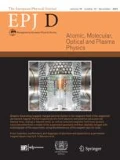Abstract:
The formalisms of many body perturbation theory and coupled cluster theory have been used to study the electronic and geometric structures of neutral, cationic, and anionic small silver clusters. Hay-Wadt relativistic effective core potentials replacing the twenty-eight core electrons and a Gaussian basis set have been used. Topologically different clusters and clusters belonging to different symmetry groups have been identified and studied in detail. Full geometry optimizations have been carried out at four different correlated levels of theories. Ionization potentials, electron affinities, and fragmentation energies of the optimized clusters have been compared with other experimental and theoretical results available in the literature. No convergence problems are encountered at the various levels of correlated theories. This is noteworthy since it has been claimed in the literature that for d elements the MP series does not converge very well.
Similar content being viewed by others
Author information
Authors and Affiliations
Additional information
Received 16 April 2002 / Received in final form 12 September 2002 Published online 21 January 2003
RID="a"
ID="a"e-mail: akr@uta.edu
Rights and permissions
About this article
Cite this article
Huda, M., Ray, A. A correlation study of small silver clusters. Eur. Phys. J. D 22, 217–227 (2003). https://doi.org/10.1140/epjd/e2003-00014-0
Issue Date:
DOI: https://doi.org/10.1140/epjd/e2003-00014-0




